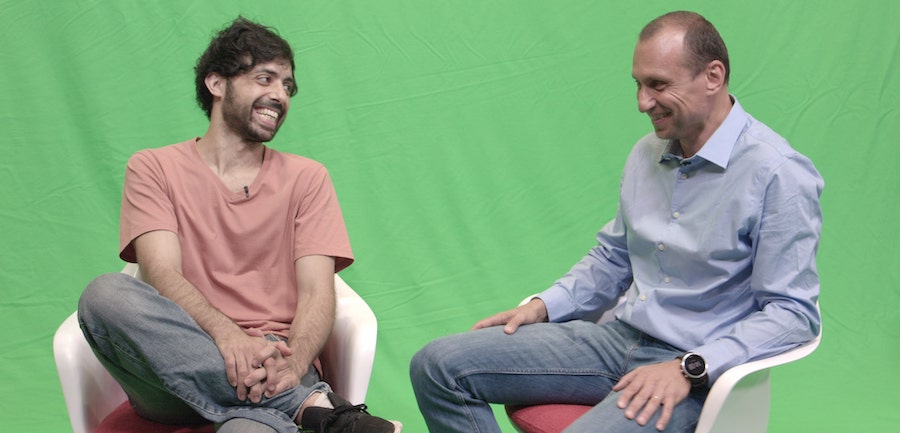Using Comedy to Teach Serious Business
On August 2, 2020, I found myself mic’d up at a studio in Southern California, preparing to host an online workshop on using humor in business education. We were about to go live, and I was wondering what I had gotten myself into.
The workshop had received top billing at the Teaching and Learning Conference held as part of the Academy of Management’s annual meeting—the biggest gathering of business academics in the world. To add to the pressure, based on its proposal, the workshop had just received the conference’s Best Session Award.
I started wondering how smart it was for a research-oriented finance professor to, one, branch out into pedagogical innovation and, two, publicly commit to doing something that had never been done at such a conference. But my co-host didn’t seem worried at all. Sammy Obeid is a cum laude graduate of the Haas School of Business at the University of California Berkeley, a former math teacher—and a standup comedian. He’s widely known as a host of the Netflix show “100 Humans.”
For our workshop, our plan was to ask our audience members to propose and vote on a topic that business school students have particular difficulties learning. Then Obeid and I would make an educational video on this topic that was “engaging and funny”—words I was committed to uttering. We would record the video a mere three days later, on August 5, the only time that would work for logistical reasons. Our pledge was to make the video publicly available no matter what.
This was, admittedly, an unusual challenge for anyone to accept. But it was also, in miniature, a reflection of the far bigger challenge that has been looming over the education industry for a long time. As the COVID-19 pandemic accelerated the digital disruption of our field, it has become more critical that we answer this question: How do we efficiently combine education and engagement?
Combining ‘Haha’ and ‘Aha’ Moments
As luck would have it, I had had a head start on tackling this challenge. Two years earlier, I had chanced on Obeid’s standup show, and I was struck by how masterfully he blended mathematical concepts with laugh-out-loud comedy. I reached out to him and proposed collaborating on an educational video I would use in one of my classes at Toulouse Business School (now known as TBS Education) in France, where I had been teaching since 1999.

Sammy Obeid (left) and David Stolin sit at a recording studio, working on a humorous educational video.
The result was so promising that Obeid was invited to collaborate with the school on a series of humorous educational videos. He became the inaugural member of the TBS Inspiring Guest project, in which our school welcomes interesting, original, and accomplished guests to collaborate on innovative e-learning content. Ultimately, Obeid and TBS created more than a dozen videos that used humor to enliven concepts from such diverse business fields as finance, international trade, marketing, and data science.
The fact that humor can be enormously valuable in the business world is persuasively argued in Humor, Seriously by Jennifer Aakers and Naomi Bagdonas, both of Stanford University. But why does humor work as an educational strategy? Striking exaggerations, insightful analogies, and unexpected associations are all parts of a comedian’s toolkit that can be used to stimulate interest in a concept, explain it in a novel way, and make it unforgettable. By producing short educational comedies—or “edcoms,” as I call them—we create synergy between “haha” and “aha” moments. We turn humor into a weapon of mass instruction.
Using Humor in the Classroom
The collaboration with Obeid has led me to believe that even if not everything should be taught through humor, everything can be. I also have formed the opinion that punctuating a course with high-quality edcoms is a powerful way to increase the engagement of the students and the professor. This is true whether a course is delivered face-to-face, online, or in a hybrid format.
I believe this to be particularly true for interactive, discussion-driven classes. A well-conceived, thoughtful, and funny three-to-five-minute edcom can provide enough colorful examples, metaphors, and memes to sustain a lively discussion for up to 90 minutes as participants keep returning to and building on ideas. In addition, the shared fun experience provides a social lubricant that helps create a positive atmosphere conducive to learning. I believe that the TBS edcoms on such different topics as market efficiency, consumer psychology, and probability updating all strongly support this proposition.
To gauge the effect of humor on the learning process, we subjected Obeid to the torturous experience of recording nonfunny versions of several of the videos so we could compare assessments of student learning. Then, as reported in a paper co-written with my TBS colleagues, we randomly assigned the humorous and nonhumorous videos to learners. We found that humor increases engagement, which in turn improves test results. However, there’s one caveat: Our finding pertains to professional-quality humor blended with educational material and does not necessarily extend to amateur or extraneous humor.
A well-conceived, thoughtful, and funny three-to-five-minute edcom provides enough colorful examples, metaphors, and memes to sustain a lively discussion for up to 90 minutes.
Our edcoms have also made an impact outside of TBS. We made the videos and the corresponding teaching notes available at no cost, and scores of business academics around the world have used them in their own teaching. In addition, our project has received high-visibility outside recognition, including the Gold Award for Best Innovation Strategy from the Association of MBAs/Business Graduates Association.
Innovating Under Pressure
But our original bet on this collaboration was nothing if not risky. The ways a comedian and an educator conceive of an exposition are very different. Obeid and I bumped heads countless times over every possible issue—scripts, pacing, visuals, slang, music, you name it.
There was also the stress that comes with any high-stakes creative endeavor. All artists know that every time they start something new from scratch, they set higher standards for themselves, and they feel a vague sense of panic that they won’t be able to meet those standards. This worry is less familiar territory to educators. If we teach a class well one year, we generally don’t seek to do something radically different the next.
Yet circumstances are increasingly requiring educators to innovate under pressure—and I was all too aware of the pressure on that August day while we were preparing to deliver our workshop at the Academy of Management conference. But I knew that our educator-comedian tandem was special, and I had to trust that our product would be, too.
The topic that emerged from the workshop was the Expectancy Theory of Motivation proposed by Victor Vroom in 1964. While the topic was new to both Obeid and me, we kept our word and recorded an edcom about it three days later. The edcom, the workshop that prompted it, and a “making of” video are all available on a dedicated webpage.
I am convinced that any well-defined topic can be turned into a helpful and engaging edcom at the hands of a committed and experienced educator-comedian team.
Since its creation, this edcom has been deployed in dozens of classrooms. For example, Eric Sanders at Elmhurst University in Illinois used the video in an online, asynchronous undergraduate course on organizational behavior. During a module on motivation, he had the 20 students in the class watch the video, then propose their own serious or funny applications of expectancy theory. According to Sanders, the video’s combination of content and humor made it an ideal starting point for a good online discussion. His student Regine Basilio, a double major in finance and human resources, found the video appealing because it was short but still included two relatable and memorable examples illustrating the theory.
Scaling Up with Humor
Did we get unusually lucky with this particular topic? I doubt it. In fact, by now I am so convinced that any well-defined topic can be turned into a helpful and engaging edcom at the hands of a committed and experienced educator-comedian team that I am willing to drone on about it for 42 minutes. Further, I believe the tension between the methodical, pedagogy-driven approach of the educator and the improvisational, free-associative one of the comedian is what makes the process work. Assuming this tension is thoughtfully managed, it almost inevitably leads to innovative solutions.
Can such innovativeness be scaled up to the organizational level? Perhaps the most persuasive affirmative answer is given in the book Creativity, Inc. by Pixar’s legendary co-founder and long-term president, Edwin Catmull. Catmull’s track record at establishing and maintaining a culture of creativity and inspiration speaks for itself, and his book is a great blueprint for any business school that aspires to put innovation at its core.
Because Catmull has extensive experience in the field of education—he holds a PhD in computer science and headed an academic department at the New York Institute of Technology—I couldn’t resist asking him about edcoms when I was getting his take on creativity in the education sector. Could he see value in scaling up the exercise, with different educator-comedian teams around the world tackling a variety of educational topics?
He replied that—from high school through college—whenever he had a teacher who was inspirational, “I was very aware that part of the inspiration is that they risked being entertaining. They were fun and their examples were irreverent at times.” So what about crowdsourcing a variety of edcoms that would be widely shared? “That seems like a really good idea.”
I took that as a “go for it.”





